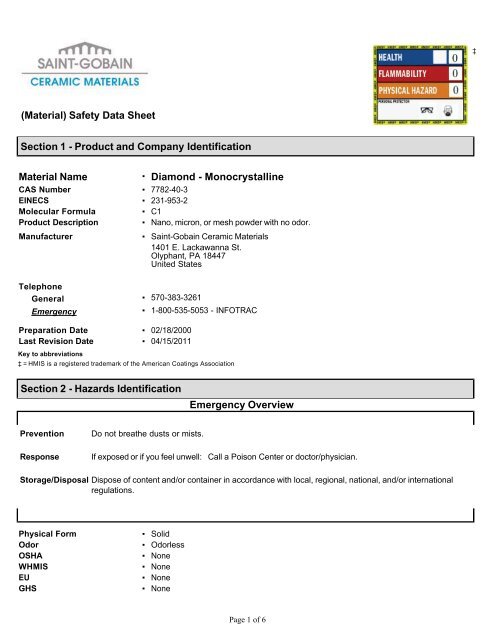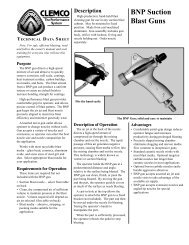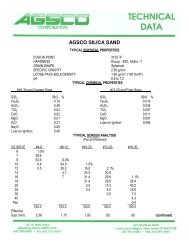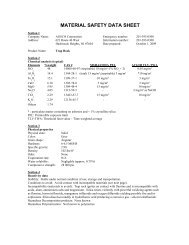Material Safety Data Sheet (MSDS) Diamond Powder
Material Safety Data Sheet (MSDS) Diamond Powder
Material Safety Data Sheet (MSDS) Diamond Powder
You also want an ePaper? Increase the reach of your titles
YUMPU automatically turns print PDFs into web optimized ePapers that Google loves.
‡<br />
<br />
<br />
<br />
<br />
▪ <br />
▪ 7782-40-3<br />
▪ 231-953-2<br />
<br />
▪ C1<br />
<br />
▪ Nano, micron, or mesh powder with no odor.<br />
<br />
▪ Saint-Gobain Ceramic <strong>Material</strong>s<br />
1401 E. Lackawanna St.<br />
Olyphant, PA 18447<br />
United States<br />
<br />
▪ 570-383-3261<br />
Emergency<br />
▪ 1-800-535-5053 - INFOTRAC<br />
▪ 02/18/2000<br />
▪ 04/15/2011<br />
<br />
<br />
<br />
<br />
<br />
<br />
Do not breathe dusts or mists.<br />
I exposed or if you feel unwell: Call a or doctor/physician.<br />
Dispose of content and/or container in accordance with local, regional, national, and/or international<br />
regulations.<br />
<br />
<br />
<br />
<br />
<br />
<br />
▪ Solid<br />
▪ Odorless<br />
▪ None<br />
▪ None<br />
▪ None<br />
▪ None<br />
Page 1 of 6
▪ Inhalation, Skin, Eye, Ingestion<br />
▪ Lungs<br />
▪ Disorders of the lungs<br />
▪ Exposure to dust may cause irritation. Nuisance dust may affect the lungs but<br />
reactions to short duration, low level dosage exposures are typically reversible.<br />
▪ Repeated and prolonged exposure to dust may cause lung injury and/or disease.<br />
▪ Exposure to dust may cause mechanical irritation.<br />
▪ No data available.<br />
▪ Exposure to dust may cause mechanical irritation.<br />
▪ No data available.<br />
▪ Excessive concentrations of nuisance dust in the workplace may cause mechanical<br />
irritation to mucous membranes.<br />
▪ No data available.<br />
See Section 12 for Ecological Information.<br />
<br />
<br />
<br />
<br />
<br />
% to <br />
Under United States Regulations (29 CFR 1900.1200 - Hazard Communication Standard) this product is NOT hazardous.<br />
In Canada, the product mentioned above is not considered hazardous under the Workplace Hazardous <strong>Material</strong>s<br />
Information System (WHMIS) This product is not considered dangerous under the European Directive 67/548/EEC<br />
According to Regulation (EC) No. 1272/2008 (CLP) this material is not considered hazardous. According to the Globally<br />
Harmonized Standard for Classification and Labeling (GHS) this product is considered not hazardous.<br />
See Section 11 for Toxicological Information.<br />
<br />
<br />
<br />
▪ Move victim to fresh air. Give artificial respiration if victim is not breathing. Administer<br />
oxygen if breathing is difficult.<br />
<br />
▪ In case of contact with substance, immediately flush skin with running water for at<br />
least 20 minutes.<br />
<br />
▪ In case of contact with substance, immediately flush eyes with running water for at<br />
least 20 minutes.<br />
<br />
▪ Rinse mouth. Do not give anything by mouth to an unconscious person.<br />
See Section 2 for Potential Health Effects.<br />
<br />
<br />
▪ Use extinguishing media appropriate for surrounding fire.<br />
Page 2 of 6
▪ No data available.<br />
▪ LARGE FIRES: Move containers from fire area if you can do it without risk.<br />
LARGE FIRES: Do not scatter spilled material with high pressure water streams.<br />
LARGE FIRES: Dike fire-control water for later disposal.<br />
Keep unauthorized personnel away.<br />
Stay upwind.<br />
▪ <strong>Material</strong> is non-combustible and is not expected to pose a fire or explosion hazard.<br />
▪ No data available.<br />
▪ Wear positive pressure self-contained breathing apparatus (SCBA). Structural<br />
firefighters' protective clothing will only provide limited protection.<br />
<br />
▪ Do not touch or walk through spilled material.<br />
▪ As an immediate precautionary measure, isolate spill or leak area for at least 25<br />
meters (75 feet) in all directions. Keep unauthorized personnel away.<br />
▪ LARGE SPILLS: Prevent entry into waterways, sewers, basements or confined areas.<br />
▪ Avoid generating dust.<br />
<br />
SMALL DRY SPILLS: With clean shovel place material into clean, dry container and<br />
cover loosely; move containers from spill area.<br />
LARGE SPILLS: Cover powder spill with plastic sheet or tarp to minimize spreading.<br />
LARGE SPILLS: Dike far ahead of spill for later disposal.<br />
<br />
<br />
<br />
<br />
<br />
<br />
▪ Avoid creating dusts. Do not use in areas without adequate ventilation. Wear eye<br />
protection (goggles, safety glasses or face mask).<br />
▪ Ventilate enclosed areas. Keep container closed.<br />
▪ No data available<br />
▪ No data available<br />
<br />
<br />
<br />
▪<br />
▪ For limited exposure use an N95 dust mask. For prolonged exposure use an air -<br />
purifying respirator with high efficiency particulate air (HEPA) filters. Follow the OSHA<br />
respirator regulations found in 29 CFR 1910.134 or European Standard EN 149. Use a<br />
NIOSH/MSHA or European Standard EN 149 approved respirator if exposure limits are<br />
exceeded or symptoms are experienced.<br />
<br />
▪ Wear safety glasses or goggles.<br />
<br />
▪ No special protection is required.<br />
<br />
▪ Wear long sleeves and/or protective coveralls.<br />
<br />
<br />
<br />
<br />
▪ Handle in accordance with good industrial hygiene and safety practice. Wash<br />
thoroughly with soap and water after handling and before eating, drinking, or using<br />
tobacco.<br />
▪ Good general ventilation and/or local exhaust ventilation should be used. Ventilation<br />
rates should be matched to conditions in order to ensure that concentrations of<br />
airborne contaminants are below applicable threshold limit values.<br />
Page 3 of 6
as Particulates not otherwise classified (PNOC)<br />
as Particulates not otherwise classified (PNOC)<br />
<br />
<br />
<br />
<br />
<br />
▪ Solid<br />
▪ <strong>Powder</strong> with no odor.<br />
<br />
<br />
<br />
<br />
<br />
<br />
<br />
<br />
<br />
<br />
<br />
<br />
<br />
<br />
<br />
<br />
<br />
<br />
<br />
<br />
<br />
<br />
<br />
<br />
<br />
<br />
<br />
<br />
<br />
<br />
<br />
<br />
<br />
▪ Stable under normal temperatures and pressures.<br />
▪ Hazardous polymerization with not occur.<br />
▪ No data available.<br />
▪ No data available.<br />
▪ No data available.<br />
<br />
Exposure to this material may cause mechanical irritation to the skin, eyes and respiratory system. Limited toxicological<br />
data is available for <strong>Diamond</strong> (7782 -40-3). Exposure to inhalable dusts, particularly prolonged or repeated exposure, may<br />
cause lung injury or disease.<br />
<br />
to 100% <br />
Page 4 of 6
▪ No data available.<br />
▪ No data available.<br />
▪ No data available.<br />
▪ No data available.<br />
<br />
<br />
▪ Dispose of content and/or container in accordance with local, regional, national, and/or<br />
international regulations.<br />
<br />
<br />
Not Regulated<br />
<br />
Not Regulated<br />
<br />
Not Regulated<br />
<br />
Not Regulated<br />
<br />
Not Regulated<br />
<br />
Not Regulated<br />
<br />
Not Regulated<br />
<br />
▪ None<br />
▪ S22 Do not breathe dust.<br />
<br />
<br />
<br />
<br />
<br />
<br />
Page 5 of 6
▪ 02/18/2000<br />
▪ 04/15/2011<br />
▪ The information contained herein is believed to be accurate. It is not intended to<br />
<br />
constitute performance information concerning the product. No Express warranty, or<br />
implied warranty of merchantability or fitness for a particular purpose is made with<br />
respect to the product or the information contained herein.<br />
<br />
<br />
Page 6 of 6















